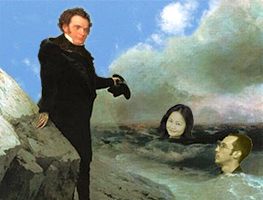
drowning Eric Wubbels,
amusing Yu Hui-Chang
Illustration by Jeff Dunn
Talk about hopeless. Yu-Hui Chang’s At the Brink of the Chill and Eric Wubbels’ Ertrinken, versinken (To drown, to sink down) projected about as much confidence for continued existence as we would give for a Chihuahua abandoned in Antarctica.
Chang’s title reflects the circumstances of composition, in late autumn of last year at Copland House on the Hudson River. As she describes it, the brilliant fall colors “soon died down, turning into a lusterless sight in less than a week’s time, surely to be followed by a long, bitter winter.”
The frenetic opening of Brink reminded me more of Manhattan traffic than fall colors, but after only three minutes this last fast music died away, leaving six remaining slow movements by the two composers till the Schubert came along. As composer Christopher Rouse asserted back in the 1980s, not enough allegros are being written today, except in remnants of minimalist practices.
Winter Dread
Chang’s second movement featured long sustained notes and chords accompanied by trickily flourishes in the piano. The third continued in the same vein, capitalizing on a dactylic bass drone; cold, ominous harmonies; and an elegiac cello melody. A climax of sorts ensued, after which the work faded out to glissandos, the bass drone, and a low lone note in the piano. Overall, Chang did a fine job of sustaining interest, however disheartening. I was thrilled to see her in person at the concert, knowing that she survived the winter intact. Couldn’t tell from the music.
Wubbels’ piece followed, with four slow movements over a 15-minute span. Each was described by the composer, who, along with Chang, was present for the premiere. In general, Wubbels explained, he is on a “project” to fuse the sounds of instruments such that the listener can’t tell which instrument is producing the heard results. Fusion is “a beautiful thing to have,” he remarked, affording listeners a chance to subsume themselves in a loss of melody and individuality. As he puts it on his Web site, he is seeking “sustained illusion of a ‘compound instrument’ made of multiple players.” His goal for the musical form that results “is that it be simultaneously rich and confusing, visceral and opaque. Something is experienced, nothing is understood.”
The music lived up to Wubbels’ billing. Each movement was an étude with a specific goal: (I) “ricocheting” notes sounding the same in strings and piano, with the help of a paper clip in the latter; (II) unison and “off-unison” lines; (III) resonance-generated “19th-century harmonies ... excited by a series of noise-composite sounds”; and (IV) a series of slow, often descending, glissandos. And the rich, confusing opacity of form was there too: Because of Morton-Feldman-like pauses and staticisms, the boundaries between movements couldn't easily be identified. Wubbels’ use of glissandos brought to mind Gloria Coates’ co-option of the technique in her symphonies, an overuse that makes me wince if I hear too many of them. Fortunately, Wubbels retreated from the Coates brink. Instead, contrary to his goal of my understanding nothing, his glissandos reinforced all too clearly my knowledge that Ertrinken, versinken is a mightily depressing piece of work, yet one that’s finely wrought and dangerously fascinating.
Sole Music
My only concern with Ertrinken was how it ended — with a flippant quote from the Schubert “Trout” Quintet that came next on the program. This was a needless splash of joviality at the funeral that was so carefully orchestrated through 99 percent of the piece, in effect a shoe thrown at the audience.After intermission, the audience at the Green Room of the Veterans Memorial building was served a delicious rendering of “The Trout.” Pianist Eric Zivian impressed with his nicely turned phrases. The passion of cellist Tanya Tomkins (who conducted the carefully timed sections of the Wubbels earlier while Leighton Fong played cello) was a joy to hear and behold. The remaining ensemble members present — Kurt Rohde, viola; Michel Taddei, bass viol; and Anna Presler, violin — all performed laudably during the three works on the program, receiving sustained applause for their efforts.
The light-refreshing waters of “The Trout” more than made up for the earlier black lagoons.

